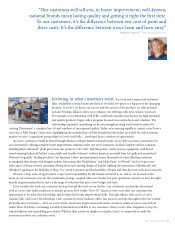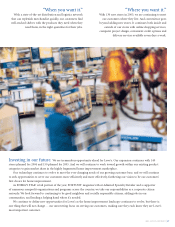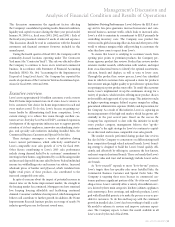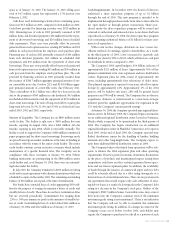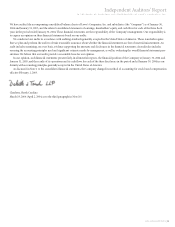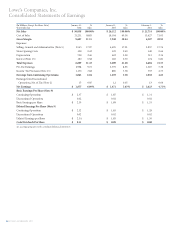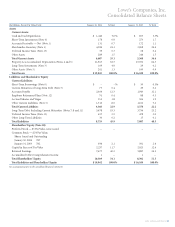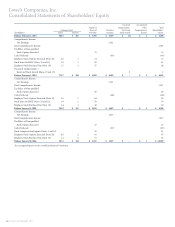Lowe's 2003 Annual Report Download - page 21
Download and view the complete annual report
Please find page 21 of the 2003 Lowe's annual report below. You can navigate through the pages in the report by either clicking on the pages listed below, or by using the keyword search tool below to find specific information within the annual report.
2003 ANNUAL REPORT 19
This discussion summarizes the significant factors affecting
the Company’s consolidated operating results, financial condition,
liquidity and capital resources during the three-year period ended
January 30, 2004 (i.e., fiscal years 2003, 2002, and 2001). Each of
the fiscal years presented contains 52 weeks of sales and expenses.
This discussion should be read in conjunction with the financial
statements and financial statement footnotes included in this
annual report.
During the fourth quarter of fiscal 2003, the Company sold 26
commodity-focused locations operating under The Contractor
Yard name (the “Contractor Yards”). This sale was effected to allow
the Company to continue to focus on its retail and commercial
business. In accordance with Statement of Financial Accounting
Standards (SFAS) No. 144, “Accounting for the Impairment or
Disposal of Long-Lived Assets,” the Company has reported the
results of operations of the Contractor Yards as discontinued oper-
ations for fiscal 2003, 2002 and 2001.
Executive overview.
Lowe’s serves approximately 10 million customers a week at more
than 950 home improvement stores in 45 states. Lowe’s vision is to
be its customers’ first choice for home improvement in each and
every market served. To do this, Lowe’s focuses on gaining cus-
tomer loyalty by differentiating itself from competitors. Lowe’s
current strategy is to achieve this vision through excellent cus-
tomer service, Everyday Low Prices (EDLP), continued expansion,
development of the appropriate infrastructure to support growth,
retention of its best employees, innovative merchandising strate-
gies, and specialty sales initiatives including Installed Sales, the
Commercial Business Customer and Special Order Sales.
These strategies encompass a variety of initiatives driving
Lowe’s current performance, which collectively contributed to
Lowe’s comparable store sales growth of 6.7% for fiscal 2003.
Other factors contributing to Lowe’s 2003 sales performance
include strong demand fueled by its customers’ commitment to
investing in their homes, supplemented by a solid housing market
and increased disposable income aided by lower Federal individual
income tax withholding rates and income tax rebates. Increased
wholesale prices of lumber and plywood, which translated into
higher retail prices of these products, also contributed to the
increased comparable store sales.
In spite of concerns about the impact of potential increases in
interest rates on the home improvement market, the strength in
the housing market has continued. Mortgage rates have remained
low, keeping housing affordable and facilitating continued
demand. Consumer confidence has improved, which management
believes will contribute to further growth. In addition, the Home
Improvement Research Institute predicts an average of nearly 5%
industry growth per year for the next several years.
Initiatives Driving Performance Lowe’s believes the EDLP strat-
egy and its low-price guarantee increase homeowner and com-
mercial business customer traffic, which leads to increased sales.
Lowe’s is able to maintain its commitment to EDLP primarily by
controlling inventory costs. The Company uses product line
reviews and its global sourcing offices in Asia and other parts of the
world to enhance margins while still providing its customers the
value they have come to expect from Lowe’s.
To ensure that Lowe’s is satisfying its customers’ needs, from
opening price points to premium products, the Company per-
forms rigorous product line reviews. Product line reviews involve
extensive market research, collaboration with vendors, and input
from cross-functional teams to identify the optimal assortments,
selection, brands and displays, as well as ways to lower costs.
Through the product line review process, Lowe’s has identified
areas in which its customers have expressed a desire for products
that are more unique, higher quality or provide more options than
an opening price point product may offer. To satisfy this customer
desire, Lowe’s implemented its up-the-continuum strategy for a
variety of products, which involves offering more product choices
in the middle and upper end of a price range. This initiative results
in higher operating margins, defined as gross margin less selling,
general and administrative expenses (SG&A) and depreciation, for
the Company. As a result of this initiative, Lowe’s is capturing an
increasing amount of the high-end market, which has grown sub-
stantially in the past several years. Based on the success the
Company has experienced to date with this initiative in nearly
every product category, management believes that “up-the-
continuum” is the right strategy for Lowe’s to continue to capital-
ize on this trend and increase comparable store sales growth.
The market research performed during product line reviews
has also led the Company to concentrate on differentiating itself
from competitors through valued national brands. Lowe’s brand-
ing strategy is designed to build the Lowe’s brand quickly, effi-
ciently, and effectively by offering its customers the best-known,
and most-respected national brands. These are brands that Lowe’s
customers value and trust and increasingly include Lowe’s exclu-
sive brands.
As “do-it-yourself” expands to more “do-it-for-me” projects,
Lowe’s targets three key specialty sales areas: Installed Sales, the
Commercial Business Customer and Special Order Sales. The
Company is targeting these areas because its commercial cus-
tomers perform a significant portion of the “do-it-for-me” remod-
eling services. Lowe’s currently offers a variety of installation serv-
ices, driven by three main categories: kitchen (cabinets, appliances
and countertops), floor coverings, and millwork products. Lowe’s
goal with all installed projects is to make the process as easy as pos-
sible for customers. To do this and keep up with the continued
growth in installed sales, Lowe’s has been working to build a scala-
ble model to enhance its services and improve customer experi-
ence. The Company expects to have this model available in all
Lowe’s stores by the end of fiscal 2004.
Management’s Discussion and
Analysis of Financial Condition and Results of Operations




